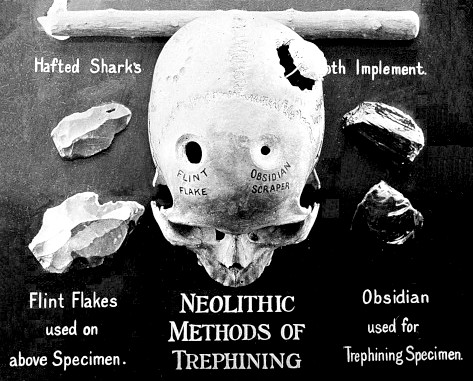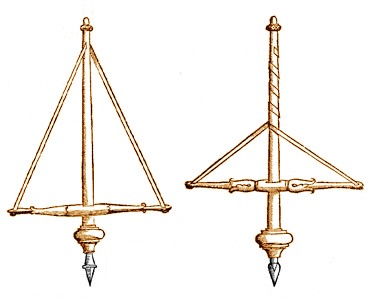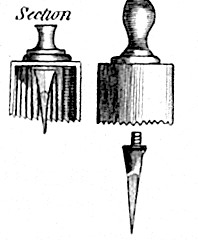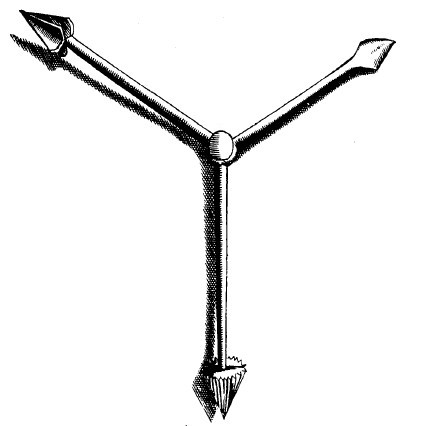
Head Surgery Tools Page Menu: 1 2 3 4 5 6 Next>>
Head Surgery Tools From the Golden Age of Piracy, Page 1

Display: Thomas Wilson Parry
Neolithic (Stone Age) Trepanning Tools From the Wellcome Collection
Trepanning the skull - drilling a hole into it - is one of the oldest archeologically-verifiable surgical operations. A variety of prehistoric and historic skulls exist showing signs of use of a trepan. Trepanned skulls dating to most periods in history have been discovered all over the world providing evidence for widespread use of this operation throughout history. Where such an operation was performed, there must also have been tools to perform them.
The earliest tools used to open the skull would have been what was available to primitive man, such as sharpened stone cutters or possibly teeth from slain animals. (See the image at left.) Examples of skulls showing trepanning from the Neolithic period suggest one of three forms of trepanning: 1) Square holes cut out using sharpened stone blades with tic-tac-toe like incisions, 2) Circular holes made by drilling a number of small, connected holes in a circular pattern (such as is seen in the top right part of the skull shown here) or 3) Circular holes made by scraping the bone with a sharpened, curved edge such as are seen in the bottom two holes in the above image.1

Terebra Unwound and Wound, Chirurgiae Universalis Opus
Absolutum, Giovanni Andrea della Croce (1573)
As time went on, man found new materials and improved his ability to work them resulting in new types of trepanning and other head surgery tools. Early surgeons used drills that were rotated by hand or in an intricate device called a terebra which went through a cross piece, each end of which was tied to to top of the drill. This was wound and released to spin (see image at right). Another version of this tool used a bow to spin the drill.
As new metals were discovered and man become more able to work them, finer and more task-oriented instruments were created, leading to the wide variety of instruments being used in head surgery. By the time of the early Greeks and Romans, many of the concepts for head surgery tools had coalesced. Historian Elizabeth Bennion explains that the trepan blade used by the ancient Greeks "was a conical piece of metal with a circular serrated edge at the base, making it

Engraver: R. Page
Trepan Blade, From the
Wellcome Collection
into a form of saw which could cut a circular groove. A centre pin kept it in place while it was worked"1. Although the handle was refined in between that time and the golden age of piracy, this basically describes the type of trepan blades used during the late 17th and early 18th centuries.
This article will focus on the tools in use during the golden age of piracy (roughly 1690 - 1725). It will begin by discussing some of the more generic tools used in this and other operations on the head. Many surgeons during this period explain that the presence of the fracture was important to determining the next step to be taken, so the tools used to detect fractures in the skull will then be discussed. Following the detection tools, tools used primarily for scraping the bone - either the existing fracture or the trepanned hole made in the skull - will be discussed. After that, the tools used to raise the cranium when it had been beaten in will be examined. Finally, tools used to cut the skull will be discussed, focusing on the various types of trepans used during this time.
1 Charles John Samuel Thompson, The History and Evolution of Surgical Instruments, 1942, pp. 36-7; 2 Elizabeth Bennion, Antique Medical Instruments, 1979, p. 29
Terminology
"In order to the Perforation of the Cranium, the Bone must be cleared of its Pericranium [the fibrous membrane covering the outside of the skull] lest in setting on the Terebra, or Modiolus, (which are two several names for a Trepan,) you tear the Membrane." (Richard Wiseman, Eight Chirurgicall Treatises, 3rd Edition, p. 381)

The Trefine... or triploides, extractor, 'drawer out', trepan, elevatorum
trepidale,
p[i]ercer or tripanon periterion, Johannes Scultetus (1674)
Terminology during the golden age of piracy was still fairly fluid. Surgery was as much an art as it was a science at this time and centuries of writing on the topic had resulted in a variety of names being applied to the same types of instruments. No where is this more evident than in tools used to operate on the head and skull.
The differences may be minor spelling variations by different authors (or sometimes by the same author), which are fairly easy to reconcile. For example, one of the tools used to scrape and smooth the skull was variously referred to as lenticular, lenticula and lenticuler.
Other times, it is a bit more confusing. A three-sided tool used to raise the skull is called by a variety of names in the surgical books including trefine, triploides, extractor, 'drawer out', trepan, elevatorum trepidale, p[i]ercer and tripanon periterion. Here, the function of the instrument will guide us to putting the tool in the proper category.
This article will use the most widely recorded version of the tool in the title of its section, with the other names found in the period and near-period resources listed below the title in parenthesis for reference and comprehension of the quoted texts.

